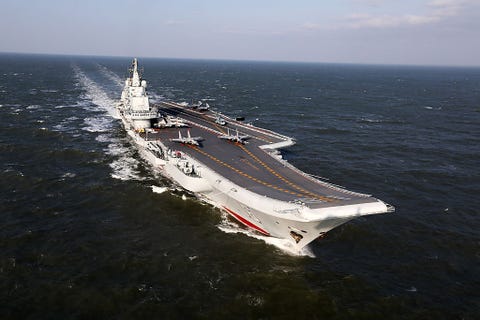China's Second Aircraft Carrier Is Its Most Crucial Yet
Unlike the first carrier, the new one was built from the ground up to Chinese requirements.

GETTY
By Kyle Mizokami
China’s second aircraft carrier is about to enter service, and unlike the first the unnamed flat-top was built exactly to the People’s Liberation Army Navy’s requirements. To the surprise of many, the ship resembles the original in many ways, improving in key ones, but leaving major design changes to future ships.
Beijing’s first aircraft carrier began life in a Ukrainian shipyard. Originally known as the Varyag, the carrier was an evolution of earlier Soviet designs that included both large numbers of ship-launched missiles but also the ability to launch and recover fixed-wing aircraft. The ship was still unfinished when the Soviet Union collapsed in 1991 and sat incomplete and exposed to the elements for almost a decade.
In 1998, the ex-Varyag was purchased by a Chinese businessman with the stated purpose of turning it into a casino. Somehow, the ship entered Chinese government hands and the unfinished carrier spent the next fifteen years being renovated, completed, and modernized. The ship was commissioned in 2012 as the Liaoning, China’s very first aircraft carrier.
Work on a second carrier began almost immediately, and the yet-unnamed ship, known only as 001A, was launched in April 2017 and nearly ready for service. The South China Morning Post compares the two ships, finding them very similar.

China’s first carrier, Liaoning, 2016.
GETTY
The two ships are dimensionally very similar, with the newer ship at most 30 feet longer than the original. Both weigh about the same, or 55,000 to 60,000 tons. The main difference between the two ships is that Liaoning was completed as a training carrier, not a combat vessel. With Liaoning, the Chinese government had to work with what the Soviets had already constructed. Liaoning is the largest ship by far ever to enter Chinese service and is meant to establish tactics, training, and procedures for China’s future aircraft carriers, on everything from deck crews to carrier takeoffs and landings.
001A is designed to be used the way U.S. carriers are, and that includes combat. The carrier can carry 35 aircraft, unlike the Liaoning which can only carry 24 fighter aircraft, and has a 12-degree slope ski jump instead of the 14 degree ski jump on Liaoning. Both carriers use ski jumps because the Soviet Union had not mastered steam catapult technology when the Varyag was under construction, and neither had China when it decided to make the ship operational. Unlike steam catapults, ski jumps limit the amount of fuel and weapons an aircraft taking off with them can carry, and the shallower angle on the newer ship should increase a jet’s ability to carry both—however slightly.
The new carrier’s island is taller but occupies a smaller footprint on the flight deck, and is crowned with four powerful S-band air search radars, a key capability since China’s carriers lack an airborne early warning and control aircraft like the E-2D Hawkeye. The smaller footprint also frees up more square footage for airplanes on the deck. The flight deck is also ringed with HQ-10 close-in anti-missile missiles, similar to the American Evolved Sea Sparrow Missile.
The new carrier is expected to enter service within the next two years. China is expected to build at least three carriers, not including Liaoning, to ensure that one carrier will be on patrol at all times. China’s next carrier will reportedly be larger and leapfrog steam technology, replacing it with an electromagnetic aircraft launching system similar to that used on the US Navy’s newest flat-top, USS Gerald R. Ford.
No comments:
Post a Comment